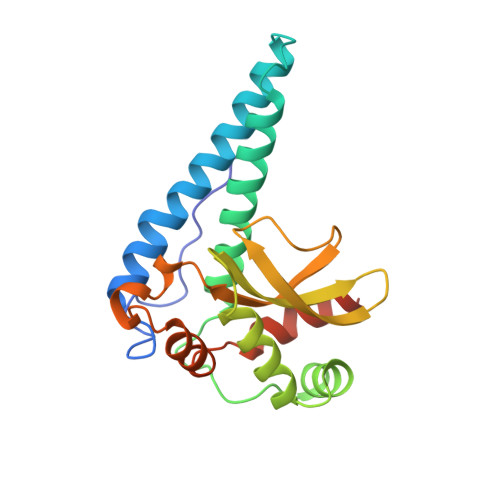X-ray structure analysis of the iron-dependent superoxide dismutase from Mycobacterium tuberculosis at 2.0 Angstroms resolution reveals novel dimer-dimer interactions.
Cooper, J.B., McIntyre, K., Badasso, M.O., Wood, S.P., Zhang, Y., Garbe, T.R., Young, D.(1995) J Mol Biol 246: 531-544
- PubMed: 7877174
- DOI: https://doi.org/10.1006/jmbi.1994.0105
- Primary Citation of Related Structures:
1IDS - PubMed Abstract:
The X-ray structure of the tetrameric iron-dependent superoxide dismutase from Mycobacterium tuberculosis has been refined to an R-factor of 0.167 and a correlation coefficient of 0.954 at 2.0 A resolution. The crystals are monoclinic P2(1) and have four subunits related by strong non-crystallographic 222 (or D2) symmetry in the asymmetric unit. 198 of the 207 amino acids of each subunit are defined by the electron density which shows that they adopt the conserved fold of other iron- or manganese-dependent SODs. The structure can be divided into two domains, the N-terminal domain involving an extended region followed by two projecting antiparallel alpha-helices, and the C-terminal domain containing four more helical segments with a three-stranded antiparallel beta-sheet inserted sequentially between the fourth and fifth helices. The catalytic iron is co-ordinated by five ligands: three histidines (residues 28, 76 and 164), one aspartate (160) and a solvent molecule. The inferred positions of protons at the active site are consistent with the solvent ligand being a hydroxide ion. This ligand interacts with His145 in the Mycobacterium tuberculosis SOD. In the highly homologous Mycobacterium leprae Mn-SOD, the histidine is replaced by glutamine, this being the only significant residue difference within 10 A of the Fe3+. The nature of the amino acid at this position may influence the metal ion specificity of these enzymes. The subunits of the Mycobacterium tuberculosis SOD associate by polar contacts to form dimers, which closely resemble those of other dimeric or tetrameric Fe- or Mn-SODs. However, the dimer-dimer interactions within the tetramer are novel, being dominated by dimerisation of the 144 to 152 loop regions which connect the outer two beta-strands of the three-membered beta-sheet. This contrasts strongly with the other tetrameric Fe- or Mn-SODs where the dimer-dimer association is dominated by the projecting alpha alpha-turn in the N-terminal domain.
Organizational Affiliation:
Department of Crystallography, Birbeck College, University of London, U.K.















